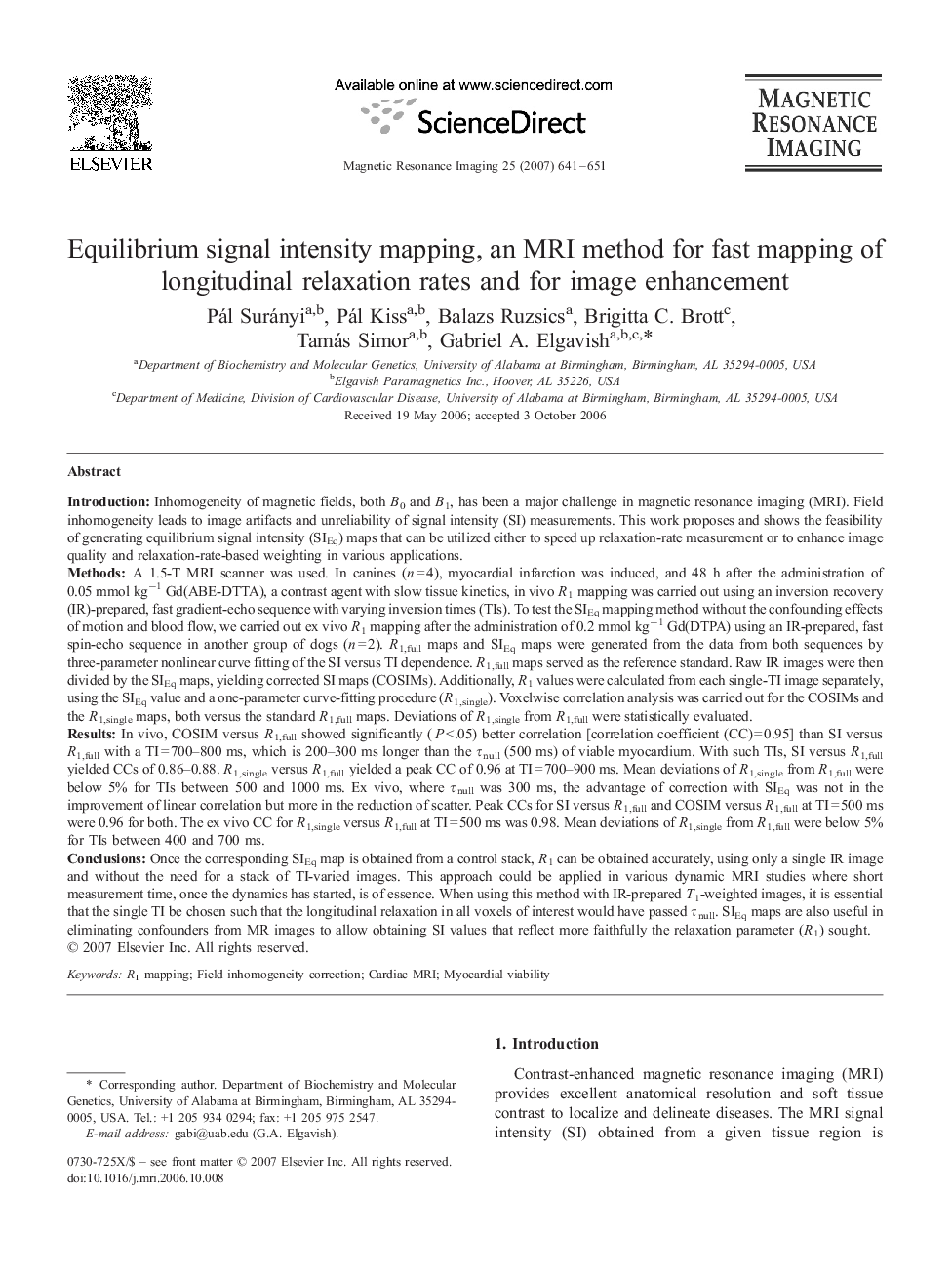| کد مقاله | کد نشریه | سال انتشار | مقاله انگلیسی | نسخه تمام متن |
|---|---|---|---|---|
| 1807642 | 1025273 | 2007 | 11 صفحه PDF | دانلود رایگان |

IntroductionInhomogeneity of magnetic fields, both B0 and B1, has been a major challenge in magnetic resonance imaging (MRI). Field inhomogeneity leads to image artifacts and unreliability of signal intensity (SI) measurements. This work proposes and shows the feasibility of generating equilibrium signal intensity (SIEq) maps that can be utilized either to speed up relaxation-rate measurement or to enhance image quality and relaxation-rate-based weighting in various applications.MethodsA 1.5-T MRI scanner was used. In canines (n=4), myocardial infarction was induced, and 48 h after the administration of 0.05 mmol kg−1 Gd(ABE-DTTA), a contrast agent with slow tissue kinetics, in vivo R1 mapping was carried out using an inversion recovery (IR)-prepared, fast gradient-echo sequence with varying inversion times (TIs). To test the SIEq mapping method without the confounding effects of motion and blood flow, we carried out ex vivo R1 mapping after the administration of 0.2 mmol kg−1 Gd(DTPA) using an IR-prepared, fast spin-echo sequence in another group of dogs (n=2). R1,full maps and SIEq maps were generated from the data from both sequences by three-parameter nonlinear curve fitting of the SI versus TI dependence. R1,full maps served as the reference standard. Raw IR images were then divided by the SIEq maps, yielding corrected SI maps (COSIMs). Additionally, R1 values were calculated from each single-TI image separately, using the SIEq value and a one-parameter curve-fitting procedure (R1,single). Voxelwise correlation analysis was carried out for the COSIMs and the R1,single maps, both versus the standard R1,full maps. Deviations of R1,single from R1,full were statistically evaluated.ResultsIn vivo, COSIM versus R1,full showed significantly (P<.05) better correlation [correlation coefficient (CC)=0.95] than SI versus R1,full with a TI=700–800 ms, which is 200–300 ms longer than the τnull (500 ms) of viable myocardium. With such TIs, SI versus R1,full yielded CCs of 0.86–0.88. R1,single versus R1,full yielded a peak CC of 0.96 at TI=700–900 ms. Mean deviations of R1,single from R1,full were below 5% for TIs between 500 and 1000 ms. Ex vivo, where τnull was 300 ms, the advantage of correction with SIEq was not in the improvement of linear correlation but more in the reduction of scatter. Peak CCs for SI versus R1,full and COSIM versus R1,full at TI=500 ms were 0.96 for both. The ex vivo CC for R1,single versus R1,full at TI=500 ms was 0.98. Mean deviations of R1,single from R1,full were below 5% for TIs between 400 and 700 ms.ConclusionsOnce the corresponding SIEq map is obtained from a control stack, R1 can be obtained accurately, using only a single IR image and without the need for a stack of TI-varied images. This approach could be applied in various dynamic MRI studies where short measurement time, once the dynamics has started, is of essence. When using this method with IR-prepared T1-weighted images, it is essential that the single TI be chosen such that the longitudinal relaxation in all voxels of interest would have passed τnull. SIEq maps are also useful in eliminating confounders from MR images to allow obtaining SI values that reflect more faithfully the relaxation parameter (R1) sought.
Journal: Magnetic Resonance Imaging - Volume 25, Issue 5, June 2007, Pages 641–651